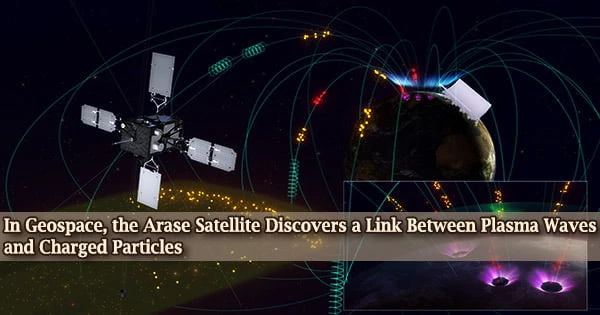Researchers from Japan show in a new study published in Physical Review Letters that high-frequency plasma waves in the Geospace can generate low-frequency plasma waves by heating up low-energy ions, revealing a new energy transfer pathway in collisionless plasma.
Plasma is a complicated fluid with numerous plasma wave modes. Kinetic pressure, as well as electric and magnetic forces, are restoring forces. Wave phenomena are significant in plasma heating, instabilities, and diagnostics, among other things.
The formation of “plasma waves,” which emerge from an instability of plasma distributions, is a characteristic feature of plasma, a state of matter defined by freely wandering charged particles interacting via electromagnetic interactions. In Geospace, “fast magnetosonic waves” (MSWs) are one type of electromagnetic plasma wave.
MSWs are “high frequency waves” that emerge from hot protons. The “electromagnetic ion cyclotron” (EMIC) wave, which is called a “low frequency wave,” is another type of wave that is regularly formed in Geospace.
Both sound and electromagnetic waves travel through the air. Both electrostatic and electromagnetic waves will propagate in plasma. Because the wave phase velocity is dependent on both the wave frequency and the angle of propagation with regard to the background magnetic field, there are many different plasma wave modes.
MSWs and EMIC waves frequently occur together, according to recent satellite findings in Geospace. The mechanism underlying this co-occurrence, however, remains unknown.
MSWs are known to occur together with the heating of low-energy protons and studies have shown that MSWs can heat up these ‘cold’ ions. With the recent observation data by the Arase satellite showing simultaneous EMIC waves, we wondered whether the appearance of EMIC waves is actually coupled with the MSW-mediated ion heating process.
Professor Yoshizumi Miyoshi
This mechanism has now been partially unraveled by a team of academics led by Professor Yoshizumi Miyoshi of Nagoya University in Japan.
“MSWs are known to occur together with the heating of low-energy protons and studies have shown that MSWs can heat up these ‘cold’ ions. With the recent observation data by the Arase satellite showing simultaneous EMIC waves, we wondered whether the appearance of EMIC waves is actually coupled with the MSW-mediated ion heating process,” says Prof. Miyoshi, explaining the motivation behind the study.
As a result, the team used a wave-particle interaction analysis method to evaluate the “cross-energy coupling” between MSWs and EMIC waves detected with the Arase satellite.
The findings were eye-opening: they discovered that while MSWs transmitted energy to “cool” protons to heat them up, a portion of that energy was used to excite EMIC waves.
The thermal velocities of electrons pouring into adjacent layers of plasma will carry information about what is happening in the oscillating region. A plasma wave is the proper name for the plasma oscillation.
Given that hot protons energized MSWs, they operated as a mediating agent for energy transfer to EMIC waves, resulting in a cross-energy coupling between hot protons, cold protons, MSWs, and EMIC waves.
While these findings are fascinating in and of themselves, Prof. Miyoshi demonstrates how they contribute to our understanding of Geospace:
“EMIC waves cause significant scattering and loss of ‘killer electrons’ in the Van Allen radiation belts which often cause satellite malfunctions. The new energy transfer route for exciting EMIC waves revealed in our study could contribute to improved space weather forecasting, making for safer operations of satellite in the Van Allen radiation belts.”





